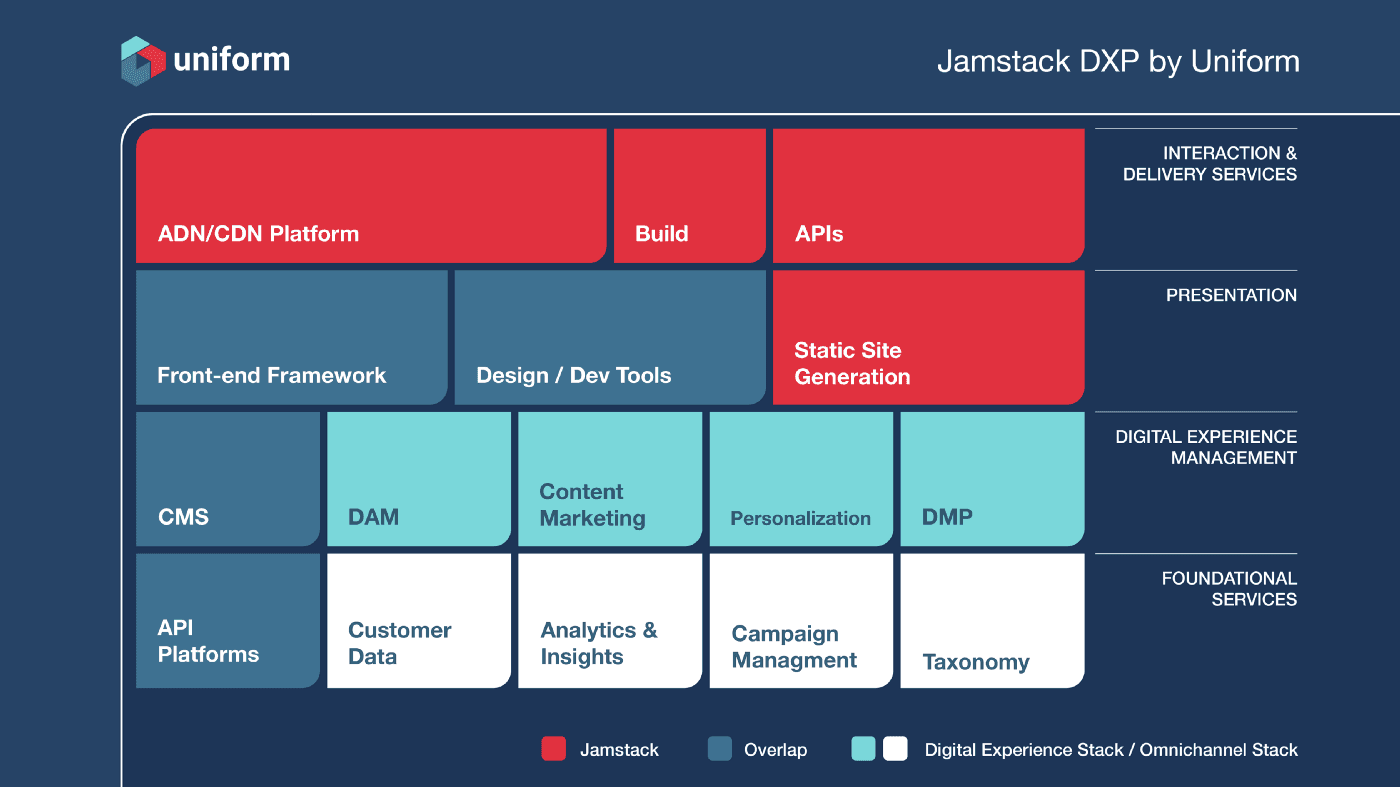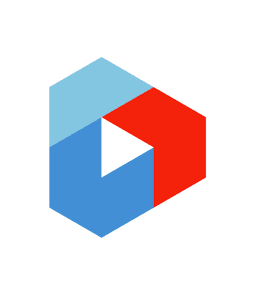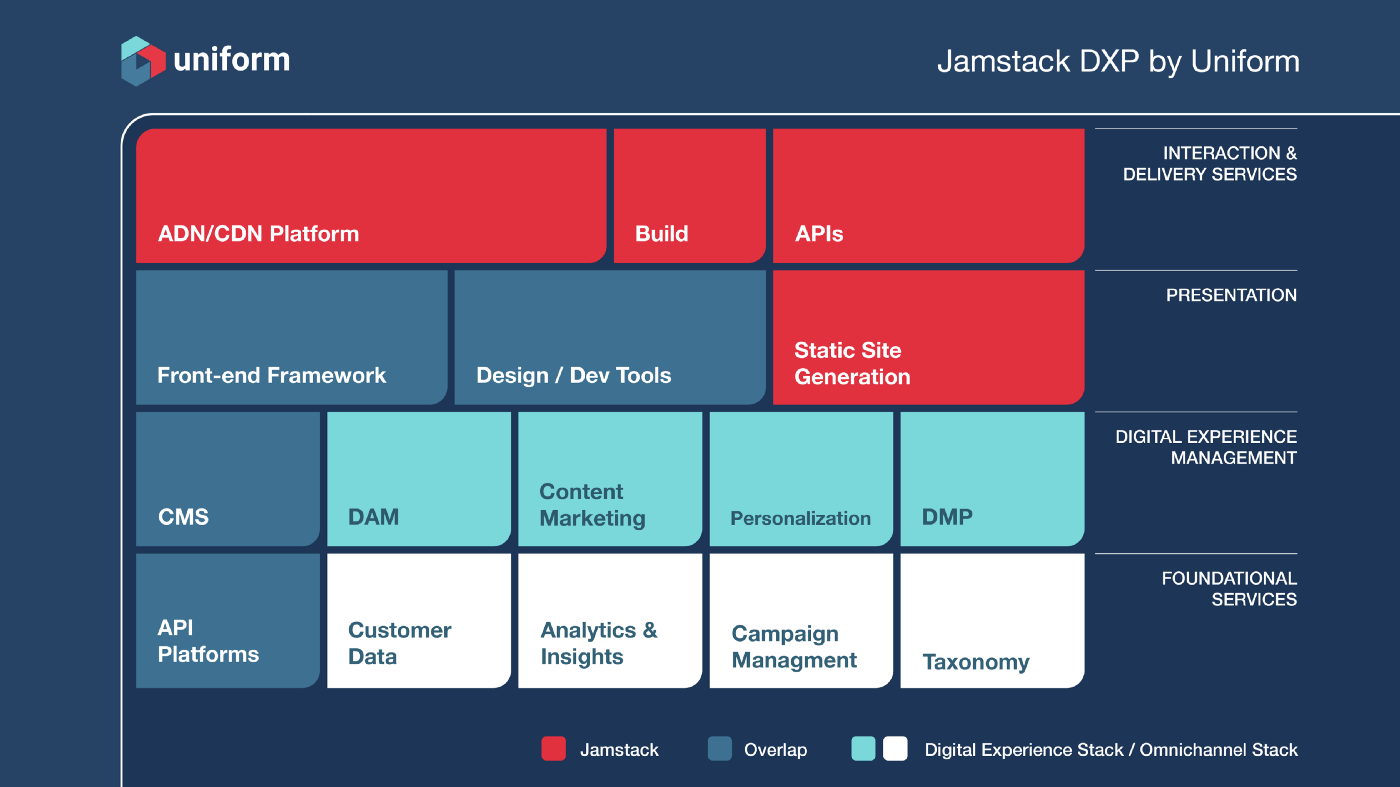Uniform blog/Reimagining DXP with Jamstack
Reimagining DXP with Jamstack
Reimagining DXP with Jamstack
Digital Experience Platforms (DXP) are an essential part of how global brands and large organizations create personalized experiences for their customers. Jamstack is an increasingly important part of building and delivering experiences to customers.
Traditionally DXP and Jamstack come from two different worlds: DXP from the marketing world and Jamstack from the IT world. While building engaging sites requires cooperation between the marketing and IT worlds, the technology focuses on one or the other. We believe there’s another way, that DXP can be reimagined with Jamstack so that organizations can get the best of both worlds.
What is a Digital Experience Platform?
Digital Experience Platforms aim to connect the various tools involved in designing, building, deploying and maintaining the experiences customers have in an organization’s digital channels. This includes things ranging from content management to digital asset management to content marketing to personalization and beyond. Both technical and business users work in a DXP.
The Digital Experience Platform is a $12 billion annual market. DXP is often described as a key enabler for companies interested in digital transformation. It allows brands to deliver personalized experiences to their customers. Personalization increases visitor engagement. Visitor engagement increases conversions. Conversions increase revenue.
Is it a platform or a product?
The word platform in Digital Experience Platform is significant. A platform is something that connects different systems or services for the sake of having those systems or services work together as a single unit. In reality, however, most DXP systems act more like Digital Experience Products rather than Digital Experience Platforms.
With a product from a single technology vendor, you expect the product itself to provide the functionality you need. For example, an essential feature of DXP is web content management (WCM). With a DXP that acts as a product, the DXP itself provides WCM functionality. The WCM functionality is considered to be tightly coupled with the DXP, meaning the WCM functionality cannot be separated from the DXP. It’s a black box.
On the other hand, with a DXP that acts as a platform, the DXP might provide its own WCM functionality, but the DXP would also allow you to replace that native WCM functionality with your own. Whether you use the native WCM functionality or bring your own, the DXP that acts as a platform works the same way.
What is the value of a platform?
While the current generation of product-like DXP systems meets the needs of many of the organizations that have invested in them, the need for platform-like DXP systems is growing rapidly. The following are some of the scenarios that are driving this need:
- Sub-second page load times for personalized pages
- Support for modern front-end development technologies
- Global scalability with no downtime and outstanding security
- DevOps efficiencies, such as instant rollbacks and deployment previews
If you are familiar with Jamstack, you may immediately identify these scenarios as being among Jamstack’s strengths. Jamstack is a specific kind of architecture that handles these scenarios well.
The current generation of product-like DXP systems does not use a Jamstack architecture. Ironically, these products evolved as alternatives to the publish-oriented design of the previous generation of products. This publish-oriented design is very similar to Jamstack architecture. The difference is that Jamstack overcomes the limitations of the publish-oriented design thanks to improvements in browser engines, JavaScript and CDN technology, and the advent of the API economy.
It is very difficult — and in some cases impossible — for the current generation of product-like DXP systems to handle these scenarios. Often they depend on heavy origin-based request processing and slow server-side rendering that is often mixed with proprietary CMS templating technologies. This creates a bottleneck for performance and scaling. Sites that are highly distributed, or that involve large amounts of dynamically generated content are especially susceptible to these limitations.
DXP inspired by Jamstack
One reason why Jamstack is exploding in popularity is that it offers flexibility, choice, performance and operational simplicity. Developers can use whatever content management system, static site generator, APIs, etc. they want. Jamstack lets developers use the right tool for the job. A DXP inspired by Jamstack would bring the same kind of flexibility and choice to digital experience management.
We are proud to announce Jamstack DXP by Uniform, the world’s first headless decoupled DXP inspired by and built for Jamstack. You get the benefits of Jamstack:
- Use your preferred static site generator, including Next.js, Gatsby and NuxtJS.
- Deploy to your preferred CDN, including Netlify, Akamai, Azure, AWS and Tencent.
- Use modern DevOps tools and practices.
…without losing the benefits of your current DXP:
- Decouple DXP functionality such as personalization and tracking so they are configured by business users in their current DXP but are executed in an origin-less manner (e.g. using Uniform’s edge-based personalization functionality).
- Keep business user functions such as contextual content authoring and preview, workflow, publishing, translation, and campaign management in place.
Jamstack inspired by DXP
Traditional DXPs are not going anywhere. These are systems that were designed for the largest brands and organizations in the world. They are used on a daily basis by marketers and other business users, not developers. These systems power and are powered by line-of-business applications that are not going to be replaced just because a new website architecture is available.
Jamstack DXP by Uniform enables customers to continue using their existing DXP and business applications. It enables the parts of those systems that are working well for a customer — such as the business user tools — to work with Jamstack tools, while enabling customers to decouple the parts that aren’t in order to leverage better solutions.

Jamstack DXP by Uniform is providing the integration platform that allows enterprises to connect the technologies that make up their Digital Experience Platform.
In addition, for customers without an existing DXP, Jamstack DXP by Uniform brings enterprise-grade personalization to headless CMS products. This is another example of bringing the best of DXP to Jamstack.
Making re-platforming a thing of the past
Jamstack DXP by Uniform enables customers to build their own DXP by using features from the systems and tools they prefer. Customers can add new products to their DXP and replace existing products. They never have to throw everything out and start from scratch.
It’s hard to think of a digital experience management project that is more expensive or riskier to an organization than re-platforming. It can be fairly easy to identify what isn’t working in a solution. It is much harder to know whether re-platforming will actually resolve those issues and what new issues will arise.
Re-platforming represents a revolution. You dismantle the old and replace it with something new. With Jamstack DXP by Uniform, re-platforming becomes a choice rather than a requirement. By enabling systems and tools to be added and removed from the DXP whenever the customer wants, the DXP becomes able to change over time. Re-platforming and migrations can be done incrementally. This is why we at Uniform say “evolution, not revolution”.
Interested in Jamstack DXP by Uniform?
Announced at the Jamstack Conference October 6th 2020, Jamstack DXP by Uniform is available for select technologies immediately and will be expanded with more connectors.
For more information about how Jamstack DXP can serve as the backbone of your marketing technology stack and enable you to meet the demands of the modern web, contact us today.






.png&w=1080&q=90)
.png&w=1080&q=90)
.png&w=1080&q=90)